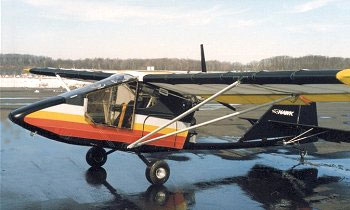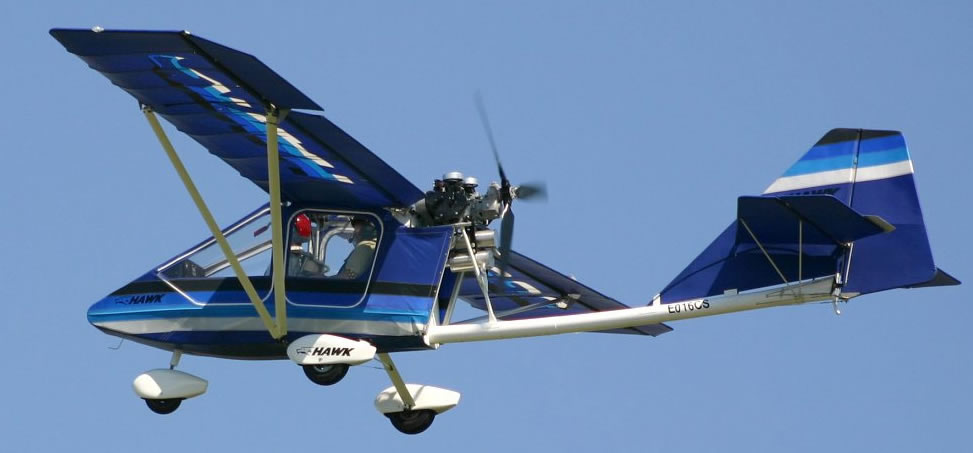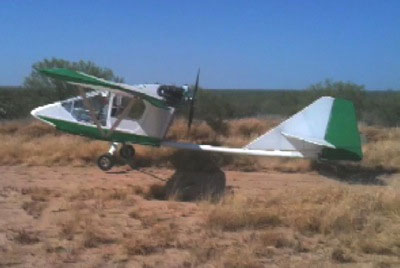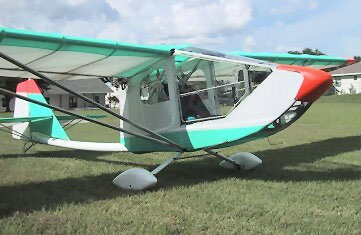| |
LP08 CGS Hawk Aviation
CGS – Office = Loveland, Ohio; Manufacturing = Cincinnati Ohio www.cgsaviation.com/
513-205-1650
Ultralight FAR 103 Aircraft - Ultralight LSA, SLSA, ELSA, AULA Aircraft
Innovators in ultralight aircraft design since 1982!

|
Hawk Arrow I
Light Sport Aircraft
The Arrow single seat wing has the same semi-symmetrical airfoil as the Arrow II, and streamlines extruded aluminum wing struts. It also includes the curved overhead and curved windshield giving it excellent flying characteristics.
The Arrow can be completed for under $25,000 with popular options. Pricing will vary depending on engine, instrumentation, and options choices.
The nose section is longer and the angles downward steeper than that of the Hawk Classic. This allows for better forward visibility at low sun angles. Since the nose was made longer, the rudder and vertical stabilizer were enlarged to maintain the same excellent yaw stability of the Hawk classic. The tail boom was reinforced to handle the loades of this larger tail assembly.
|

|
The Hawk Arrow II
This two-seater offered in kit form, to be built as an Amateur-Built Experimental or ELSA aircraft in the U.S. or AULA in Canada and the rest of the World. The long streamlined cockpit area has a flat floor, and a low sloping windshield that gives unobstructed forward visibility. The large vertical tail balances the long nose, which yields excellent yaw stability. The Arrow II wing has a semi-symmetrical airfoil, and streamlined extruded aluminum wing struts. All Hawks incorporate a curved front spar carry-through, allowing for ample head room, even for taller pilots.
The rear seat is higher than the front seat, so the field of vision of the passenger or instructor in the rear seat is less obstructed. Flaps (not flaperons!) are standard equipment on all Hawks, and are very effective in increasing climb rate and decreasing landing distance. At the heart of the Hawk's unique design is its curved boom tube. The curved boom allows the horizontal stabilizer to be placed above the down-wash of the wing, especially when flaps are deployed. Another benefit of the curve is short landing gear legs, which makes it easier to get in and out of your plane. The curved boom is stronger in torsion than a straight boom, and allows the airplane to rotate for takeoffs and landings without banging the tail on the ground. |

|
Hawk Plus
While the single seat Hawk Classic and Arrow models have large baggage areas behind the seat, it can be difficult to place large bulky items back there. The Plus was designed to accommodate the requests of customers needing a larger cargo capacity. The Hawk Plus uses the same fuselage at the two seat Arrow, but with only the front seat. Wing tanks are standard on the Plus, so the rear area is completely unobstructed for hauling cargo, additional fuel tanks, or a passenger in a jump seat. We have put four large filled duffle bags on board and still had room for the small stuff. With the larger engine options offered, up to 250 lbs. can be carried in the rear baggage area.
Another feature of the Hawk Plus is the wing spars, which are stronger than those found on standard single seat models. They are 2 1/4" dia. X .083 (instead of .049) wall thickness to provide the same load factors as the single place models. The Hawk Plus also has the semi symmetrical wing, streamline struts, reinforced boom, wing tanks, fiberglass nose cone, folding tail, and curved overhead and windshield as standard equipment.
|

|
Hawk "Sport"
Single Seat Sport is the "Hot Rod" version of the standard Classic Single Seat. It was first developed to compete in the European World Air Games in 1999. This competition is held once every two years in different countries. In the last three competitions at the World Games, the Hawk Sport and it's owners have won First Place (two competitions in a row), Second Place, and a Third Place.
The Hawk Sport differs from a Classic in several ways. First, It has a double surface wing with a semi symmetrical airfoil instead of a flat bottomed one like the standard Classic. This is achieved by the addition of lower rib battens on the lower surface of the wing forming the airfoil. This allows the stall speed to remain the same but the top speed to increase. The wing struts are a fully streamlined aluminum extrusion, which doesn’t require the use of jury struts. This allows for less drag and more speed, or you can cruise at the same speed with a lower power setting. In addition, the gear legs have streamline fairings over the fiberglass gear legs for even more drag reduction. The Sport also incorporates a curved overhead and curved windshield as standard equipment. The curved overhead offers taller pilots an additional 3 " of headroom; enough for tall pilots with helmets. A fiberglass nose cone also reduces drag and offers a sleeker appearance. |
Additional
| |



